
| WWT Shows | CLICK TO: Join and Support Internet Horology Club 185™ | IHC185™ Forums |

|
• Check Out Our... • • TWO Book Offer! • |
Welcome Aboard IHC185™  Internet Horology Club 185
Internet Horology Club 185  IHC185™ Discussion Site Main Page
IHC185™ Discussion Site Main Page  Horological Discussions, Questions and Answers
Horological Discussions, Questions and Answers  Pocket Watch Discussions
Pocket Watch Discussions  Waltham's Opera watch (and predecessor)
Waltham's Opera watch (and predecessor)
 Internet Horology Club 185
Internet Horology Club 185  IHC185™ Discussion Site Main Page
IHC185™ Discussion Site Main Page  Horological Discussions, Questions and Answers
Horological Discussions, Questions and Answers  Pocket Watch Discussions
Pocket Watch Discussions  Waltham's Opera watch (and predecessor)
Waltham's Opera watch (and predecessor)Go  | New Topic  | Find-Or-Search  | Notify  | Tools  | Reply to Post  |  |
Waltham's Opera Watch has been discussed in a couple of different threads, and I thought that I would try to bring some of it together here. Photos of some have been shown in the PHOTO GALLERY. More recently the Opera Watch has been compared with Elgin's Francis Rubie dress watch. This watch is a complex one to disassemble. To remove it from the case there are two screws that hold the movement inside the spacer (sort of) and three screws that hold the filigree piece. It is the filigree piece that holds the entire affair in the case.  | |||
|
The movement is now seen to be held in a solid metal spacer, and it is held in place by the dial (removed by loosening three typical dial screws in the edge of the spacer) and then three more under-dial screws holding it in the spacer. 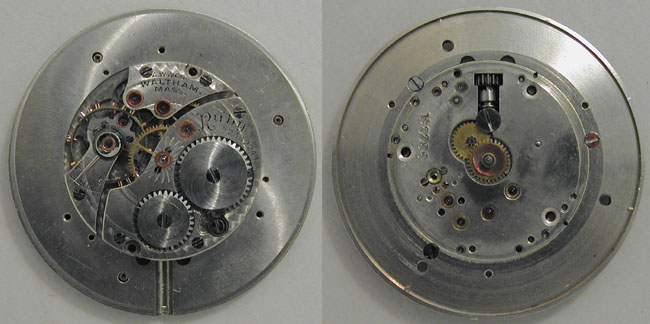 | ||||
|
Here is the front of the spacer and the back of the dial. It is difficult to see in a picture, but the dial is curved at the edges, so that it warps down into the edge of the solid spacer. Three dial feet on the back of the dial fit into appropriately spaced holes in the spacer. 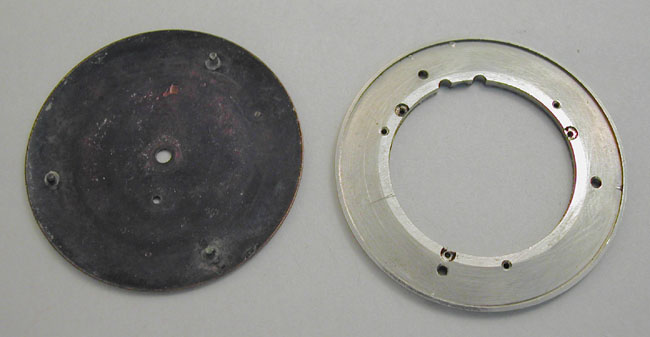 | ||||
|
And here are both spacers, without the movement. 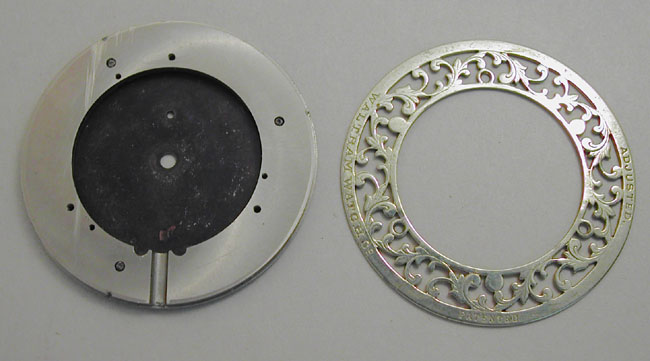 | ||||
|
The "Opera Watch" is actually just one step in a long line of watches made by Waltham and other companies to produce a slim gentleman's dress watch. The first 12-size made for the gentleman (as opposed to some earlier keywind models that were probably for ladies and boys) was E.Howard's J-SIZE watch, first manufactured in 1891. It was certainly smaller than the typical 16 or 18 size watch worn by most men, but it was not slim. Waltham's 1894 model 12-size (released around 1896, and Elgin's 2nd model were thinner than the J-size. But in 1902 Waltham made an attempt to put on the market an even smaller man's watch, their grade 1015 10-size. This was based on their 0-size 1900 model, but was dedicated as a 10-size movement, having only the serial number on the movement and the company name on the accompanying spacer. There was one production run of 4000 watches (10,173501-10,177500). It is a nice looking 15-jewel movement with gold jewel settings and requires a special case. Unfortunately it was not a success. The market was not ready for a 10-size man's watch and by 1904 company correspondence indicates that the company was anxious to be rid of the last 2000 unsold movements. 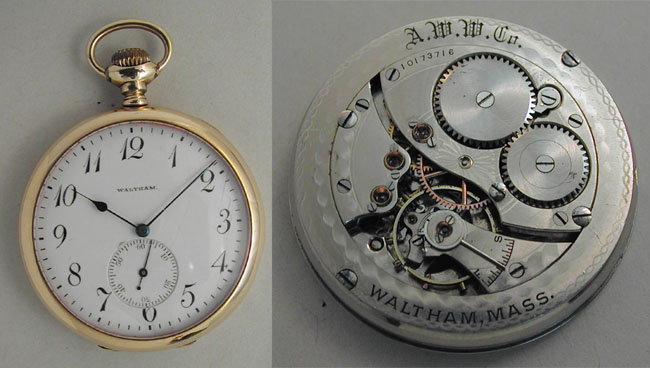 | ||||
|
The previous post show the dial typically found on this watch. Here is another, unused dial, that seems to only fit this watch. 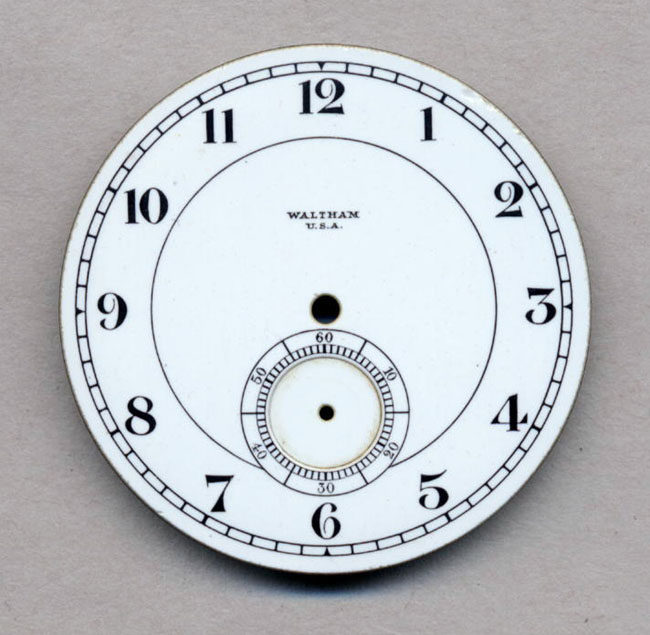 | ||||
|
And here is another view of the movement (with dial) and the spacer. These are also difficult to remove from the case, because a long stem passes through the spacer to the movement. The movement and dial must be carefully removed before the spacer comes out of the case. [Actually, upon trying to put the beast back together I find one must juggle the dialed movement and the ring at the same time to ease it into the case without stressing the dial]. 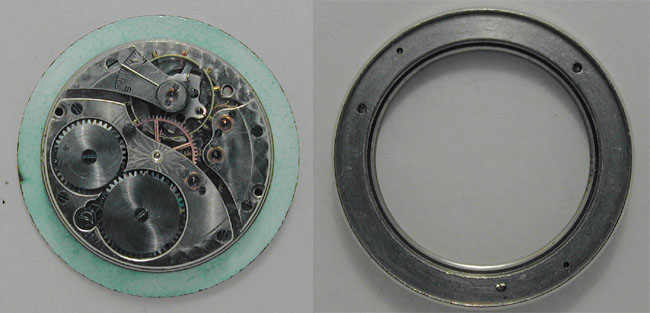 | ||||
|
Although the casing of Elgin's Francis Rubie certainly seems to mimic the Opera Watch, stylistically, the construction and use of the 0-size movement and spacer seems more inspired by this early 10-size watch. So, did Waltham's Opera Watch copy the styles of the Elgin Francis Rubie or was it the other way around? A challenge for us will be to find period advertising to try to establish which really came on the market first. I believe that South Bend and Rockford also produced similar 0-size based dress watches, and it would be an interesting research project to see where they fit in the timeline as well. | ||||
|
| Powered by Social Strata |
| Your request is being processed... |
|
Welcome Aboard IHC185™  Internet Horology Club 185
Internet Horology Club 185  IHC185™ Discussion Site Main Page
IHC185™ Discussion Site Main Page  Horological Discussions, Questions and Answers
Horological Discussions, Questions and Answers  Pocket Watch Discussions
Pocket Watch Discussions  Waltham's Opera watch (and predecessor)
Waltham's Opera watch (and predecessor)
 Internet Horology Club 185
Internet Horology Club 185  IHC185™ Discussion Site Main Page
IHC185™ Discussion Site Main Page  Horological Discussions, Questions and Answers
Horological Discussions, Questions and Answers  Pocket Watch Discussions
Pocket Watch Discussions  Waltham's Opera watch (and predecessor)
Waltham's Opera watch (and predecessor)©2002-2025 Internet Horology Club 185™ - Lindell V. Riddle President - All Rights Reserved Worldwide

